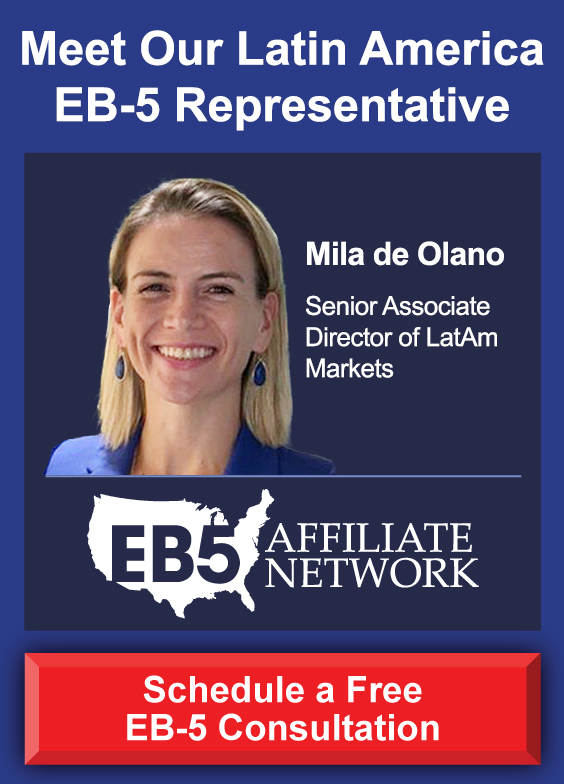
Once they are eligible, foreign nationals can file Form I-485 to adjust their immigration status and gain lawful permanent residency in the United States.
However, processing times can be long and unpredictable. Delays can affect investors’ immigration plans. With a focus on the EB-5 Immigrant Investor Program, this article explains what you should expect when submitting your I-485 and how to reduce your processing time.
Regardless of whether you’re an EB-5 investor or not, by reading this article, you will learn more about Form I-485.
We will cover why Form I-485 is important, how long it takes to process, and what EB5AN can do to help applicants obtain U.S. Green Cards under the EB-5 program.
Key Points to Remember About I-485 Processing

- Foreign nationals and their qualified immediate relatives should file Form I-485 once they have met eligibility requirements to receive conditional permanent resident status in the United States.
- I-485 processing times vary depending on individual circumstances, immigration officials’ workloads, and other factors, but expect the process to take several months at least.
- EB-5 investors can minimize I-485 processing delays by following instructions carefully, filling out all paperwork completely and accurately, and working with EB5AN and an experienced immigration attorney, among other steps.
What Is Form I-485?
Qualified individuals who live in the United States on temporary visas may wish to change their immigration status to lawful permanent resident. To do so, they must file Form I-485, Application to Register Permanent Residence or Adjust Status. This is also known as an application for adjustment of status.
EB-5 investors who are already physically present in the United States and partway through the EB-5 application process may submit this form to gain conditional permanent residency. Approval of this form makes them U.S. Green Card holders. They continue to live, work, and travel in the United States while fulfilling the EB-5 program’s requirements.
The investor’s entire family, including the EB-5 principal applicant, their spouse, and unmarried children under 21 years old, can obtain permanent residence. Each family member must submit their own Form I-485 to receive Green Cards and become conditional permanent residents of the United States.
It’s important to note that EB-5 applicants who are outside of the United States are not eligible to submit Form I-485. Instead, they must file Form DS-260 and complete consular processing before they can travel to the United States. Read our guide to DS-260 applications to learn more about that.
How Long Does It Take to Process Form I-485?
Unfortunately, an I-485 petitioner cannot expect their I-485 application to be processed by a set date. Processing times vary.
Between FY 2019 and FY 2023, the median processing time for decisions on employment-based I-485s dropped from 10 months to 8.6 months. This estimate may change again by the time you read this.
For the latest figures, consult the United States Citizenship and Immigration Services Historical National Median Processing Time page.
Factors That Affect Processing Times

These are some of the main things that can affect how long it takes for an I-485 petition to be adjudicated:
- Immigrant category.
- Processing center.
- USCIS workload.
- Eligibility of applicant.
- Problems with investor’s submission.
Let’s take a closer look at each of these issues.
Immigrant Category
Not all I-485 applicants file under the same category. One applicant may be an EB-5 investor, while another may have been granted refugee status. Some immigration categories may result in greater scrutiny from the United States Citizenship and Immigration Services (USCIS). This additional attention can lengthen the processing time.
Processing Center
One of the key factors affecting I-485 processing times is the applicant’s local USCIS field office or service center. Staffing levels change. Not every USCIS field office or USCIS service center takes the same amount of time to adjudicate an I-485 application.
USCIS Workload
A variety of issues—such as the volume of applications, changes in rules and regulations, priorities, and immigration policies—can affect the workloads of USCIS field offices. These can also affect when applicant interviews can be scheduled and conducted. As workloads change, so too can I-485 processing times.
Eligibility of Applicant
Not all foreign nationals are eligible to apply for adjustment of status. Those who fall under certain grounds of inadmissibility, as addressed in the Immigration and Nationality Act, are ineligible. These categories include:
- Medical.
- Criminal.
- National Security.
- Fraud.
The adjudication process can also involve background checks, which can take additional time.
Problems with Investor’s Submission
Immigration officials may have follow-up questions or require petitioners to supply additional documentation. This is more likely to happen if applicants make mistakes in filling out their form or omit important information.
Petitioners must prepare and fill out their paperwork carefully to avoid delays or rejection.
An I-485 applicant might encounter any combination of these factors, making it difficult to predict when their application will be adjudicated. Once the decision is made, USCIS will notify applicants by email or physical mail to indicate the application has been processed.
What Is the I-485 Timeline

Filing Form I-485 is just one part of the EB-5 immigration process. It is essential for EB-5 investors to understand how Form I-485 fits into it.
These are the main steps before, during, and after I-485 submission:
- Confirm visa availability.
- Compile essential documents.
- File Form I-485 concurrently with Form I-526 or I-526E.
- Save receipt notice.
- Participate in a biometrics appointment and interview (unless waived).
- Get Employment Authorization Document and travel permit.
- Get Green Card(s).
- File Form I-829.
- Apply for U.S. citizenship.
Let’s explore each step in more detail.
1. Confirm Visa Availability
First, a foreign national must confirm that a visa is available in their immigration category. The time needed to complete this step will vary depending on your individual circumstances.
Study the State Department’s Visa Bulletin, found here. If a visa is available, file Form I-485 using the listed “date for filing.” If one is not available, use the listed “final action date.”
In addition, do the following:
- Look up your visa type in the first column of the corresponding chart (“employment-based” if you are an EB-5 investor).
- Look up the corresponding date under the country you are from.
- File the adjustment of status form if the chart says “C,” for current.
2. Compile Essential Documents
You must provide a great deal of evidence and many supporting documents to get approval from USCIS of your Form I-485. The time needed to complete this step will vary depending on your individual circumstances. Evidence required includes:
1. Proof of eligibility: If you file Form I-485 concurrently with your I-526/I-526E immigrant petition, include a copy of the I-526/I-526E. If you do not engage in concurrent filing, include a copy of Form I-797, Approval or Receipt Notice.
This is USCIS’ official acknowledgment of the immigrant petition. Either document demonstrates that the individual can apply for adjustment of status.
2. Personal records: Copies of your birth certificate, marriage certificate (if you are married), and divorce certificate (if you are divorced).
3. Photos: Two identical, passport-style color photos that were taken less than 30 days prior to your I-485 submission date.
4. Passport and immigration documents: Copies of your complete passport (or another government-issued identity document) and paperwork that shows you were inspected by an immigration officer and admitted or paroled into the United States.
5. Criminal history records: Documentation of your criminal history, if applicable.
6. Medical records: Your vaccination records and medical evaluations.
7. Biographic information: Each of your eligible family members should complete and file Form I-130, Petition for Alien Relative.
You must also include the correct filing fee. The amount is $1,440 (including biometric services), effective April 1, 2024.
USCIS will reject any application filed on or after this date if the updated fee is not enclosed.
3. File Form I-485 Concurrently with Form I-526E
To save time, it’s a good idea to file Form I-485 and Form I-526/I-526E concurrently. There is no need to wait for USCIS to receive or approve the I-526/I-526E. If filing based on an approved or pending I-526E, include a copy of your receipt notice with your Form I-485 submission.
An EB-5 investor should send Form I-485 to the appropriate filing location. This is a USCIS lockbox, which collects documents and filing fees.
Review the list of USCIS direct addresses for the latest guidance before mailing.
4. Save Receipt Notice
Within one month of filing Form I-485, USCIS should send you an acknowledgment—Form I-797C, Notice of Action—that it has received your application. This will include a 10-digit number. Save a copy of this receipt notice and use the number to track the status of your case.
An approval notification means you will receive a conditional Green Card, can stay in the United States legally, and can proceed to the next step of the EB-5 process. A rejection notification—prompted by mistakes or omissions in your form—will delay your I-485 processing time.
Tens of thousands of I-485 applications are rejected each year. Fill out your form with care so yours is not one of them.
5. Participate in a Biometrics Appointment and Interview
Within a few months of filing Form I-485, USCIS should contact you to set up your biometrics appointment. USCIS will notify you of the location, date, and time. It is best to accept the date and time offered if at all possible, to avoid a potentially time-consuming effort to reschedule.
You will have to bring a government-issued ID to enter the USCIS facility. At your appointment, expect to have your fingerprints, photo, and signature taken.
6. Apply for EAD and Travel Permit
EB-5 applicants can still work and travel while their I-485 petitions are pending, but they must first have additional applications approved to avoid being disqualified.
To work for an employer who requires a work permit, submit file Form I-765, Application for Employment Authorization. Submitting Form I-765 means you can get an Employment Authorization Document (EAD).
After your I-485 is approved, you no longer require an EAD to work in the United States. The Green Card itself provides employment authorization.
To travel, file Form I-131, Application for Travel Document to USCIS. Approval means to receive advance parole and may travel outside the United States temporarily.
Within a few months of filing Form I-485, you can expect to receive a decision on your EAD. A decision on an advance parole travel document may take several months.
7. Get Green Card(s)
The I-485 is approved after USCIS determines the applicant has met all I-485 requirements and the U.S. Department of State assigns an immigrant visa.
Permanent Resident Cards (Green Cards) should arrive in the mail a few weeks later.
With their I-485 approved, an EB-5 investor has conditional permanent resident status for up to two years.
The investor should submit an I-829 petition during the last 90 days of this time frame to remove conditions and become a lawful permanent resident of the United States.
8. File Form I-829
To get unconditional permanent residency, the investor files an I-829 petition, which proves the investment complied with the EB-5 program.
Once the investor’s I-829 petition is approved, the investor, their spouse, and any unmarried children under the age of 21 gain lawful permanent resident status. All conditions are removed at this time.
9. Decide Whether to Apply for U.S. Citizenship
After EB-5 investors have been Green Card holders for five years, they can apply for U.S. citizenship. Many choose to do so. Full citizenship confers additional pluses, such as voting rights, eligibility for U.S. passports, and the chance to receive benefits from government programs like Medicare and Social Security.
U.S. citizenship also comes with additional responsibilities, such as exclusive allegiance to the United States, following U.S. laws, and possible jury duty service.
Applying for citizenship under these circumstances is called the naturalization process. A qualified foreign national must file Form N-400, Application for Naturalization, for USCIS approval, among other things.
Applicants should expect this process to take six months or longer.
How Can Investors Speed Up I-485 Processing?

Investors must take care to fill out their I-485s completely and accurately, to avoid mistakes and questions that could lengthen their processing time.
USCIS sometimes denies applications that are not filled out correctly. In most cases, these decisions cannot be appealed.
Here are some of the things you can do to get approved the first time you apply with minimal delay.
- Fulfill all eligibility requirements for adjustment of status.
- Use the most recent version of Form I-485.
- Familiarize yourself with and follow the filing instructions.
- Answer all application questions fully and correctly.
- Type your responses or write them out using a black pen.
- Enclose all supporting documentation and the filing fee.
- Review this checklist of evidence from USCIS.
- Provide photos consistent with the requirements outlined in the form instructions.
- Consult with a qualified immigration lawyer when drafting and filing Form I-485.
- Fill out and enclose Form I-693, Report of Immigration Medical Examination and Vaccination Record.
- Submit Form I-485 and Form I-526/I-526E concurrently.
- Reply to all questions from USCIS quickly.
Request Expedited Processing from the USCIS Contact Center
EB-5 investors may request expedited processing of their I-485 applications by getting in touch with the USCIS Contact Center.
Call them at 800-375-5283 (from inside the United States) or 212-620-3418 (from outside the United States). Their webpage also offers many online tools.
USCIS is selective in considering expedite requests, and could ask for supplementary information.
Choose EB5AN for the Best Chance of Success

Submitting Form I-485 is an important part of the EB-5 visa process, but prospective investors should familiarize themselves with all aspects of the EB-5 journey.
You’ll need help from an industry leader for the best chance of securing immigrant visas for yourself and family members.
EB5AN has helped thousands of clients from all over the world become Green Card holders. With a 100% USCIS project approval rate, our expert team can help you with everything from filing petitions to finding top-notch regional center projects.
Book a free consultation with us to learn more.










































































